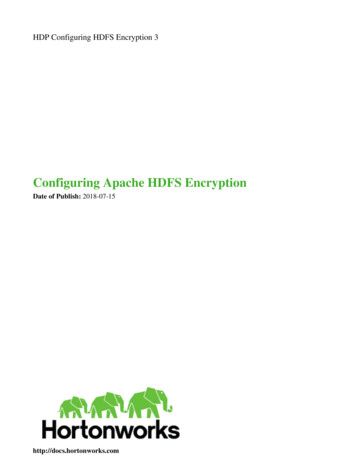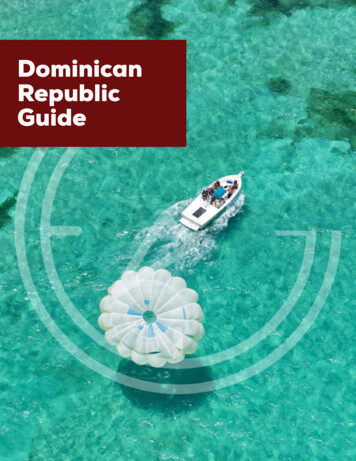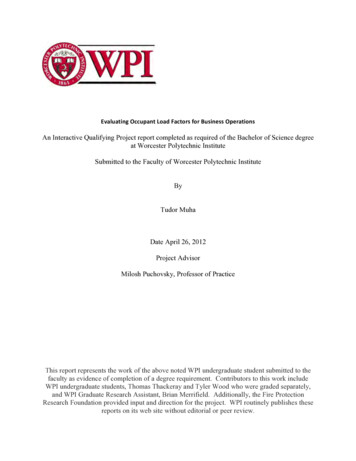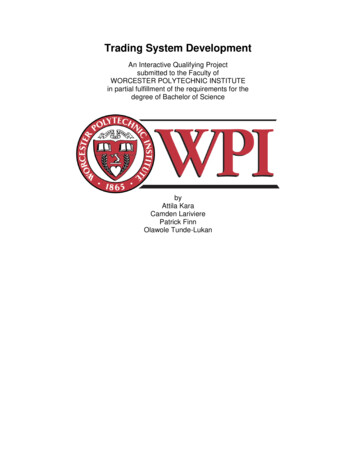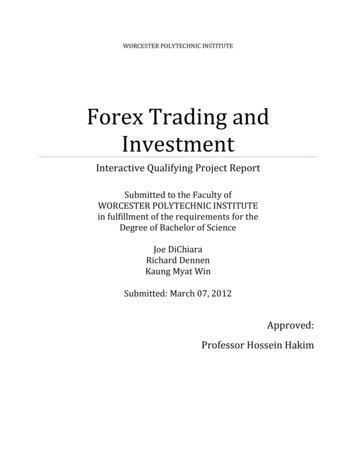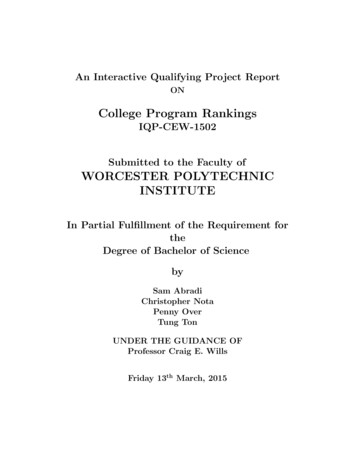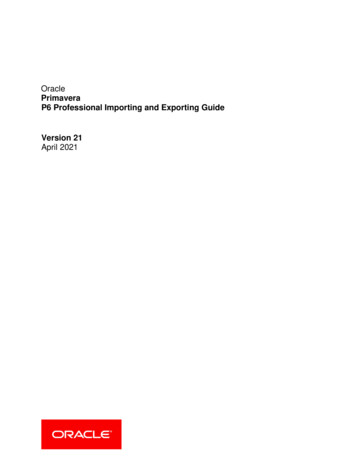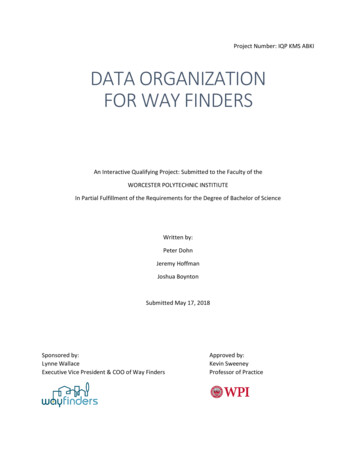
Transcription
Project Number: IQP KMS ABKIDATA ORGANIZATIONFOR WAY FINDERSAn Interactive Qualifying Project: Submitted to the Faculty of theWORCESTER POLYTECHNIC INSTITIUTEIn Partial Fulfillment of the Requirements for the Degree of Bachelor of ScienceWritten by:Peter DohnJeremy HoffmanJoshua BoyntonSubmitted May 17, 2018Sponsored by:Lynne WallaceExecutive Vice President & COO of Way FindersApproved by:Kevin SweeneyProfessor of Practice
AbstractThis project helped Way Finders, a non-profit affordable housing organization based in westernMassachusetts, understand its organizational and strategic data more effectively. The objectives of theproject included organizing and analyzing data from existing systems and analyzing customersatisfaction data. The team produced a working Access database prototype with recommendations onhow to improve it further. A set of focus group questions was drafted and submitted to Way Finders.The team also provided recommendations for Tableau data integration using Excel VBA and Salesforceserver options.i
AcknowledgmentsThe team would like to acknowledge several individuals for helping with this InteractiveQualifying Project (IQP). We would like to thank Lynne Wallace, Way Finders’ Executive Vice Presidentand Chief Operating Officer, and Lori Murphy, Lynne Wallace’s Executive Assistant, for their help in ourinitial meeting with Way Finders and for answering our questions about the project through email. We’dalso like to thank Ron Krakowiak and Michael Downs, from Way Finders’ IT department, for helping toshare Way Finders data with the team and showing the team how Way Finders collects data and howthey use the data they have collected. The team would also like to thank the Vice Presidents of each lineof business for assisting the graduate team in the setup of the project. Finally, the team would like tothank WPI Professors Kevin Sweeney and Fabienne Miller, and the WPI graduate team consisting of LeyiHu, Tina Marie Aguiar and Fatima Varzgani for helping guide the project.ii
Executive SummaryWay Finders is a Massachusetts based non-profit organization dedicated to creating affordablehousing to help eliminate homelessness and to help those struggling to pay for traditional housing. WayFinders hopes to meet this goal using a variety of different strategies. These include: building affordablerental apartments, moving the homeless to emergency shelters, and by building the community throughworkshops.There were two Worcester Polytechnic Institute (WPI) teams that worked to assist Way Findersin their mission to assist the residents of Western Massachusetts. The first was a three-personundergraduate team working on their Interactive Qualifying Project (IQP). The second team consisted ofthree graduate students from the Robert A. Foisie School of Business at WPI. The purpose of thisgraduate team is to provide additional support, in the form of their greater business managementexperience to the undergraduate team. During the project, the undergraduate team worked with avariety of tools to accomplish their objectives. These tools included Microsoft Access and Excel VisualBasic for Applications (VBAs), the data management softwares Salesforce and Tableau, and a set ofinterpersonal data collection techniques. Microsoft Access is a database management tool that can beused to construct and run databases. VBA macros are part of the Microsoft suite that can be used withvarious Microsoft Office products. The macros are programmable scripts that can be written to operatein Excel as desired. Salesforce is a major customer relationship management service. It stores data onthe cloud for the customers. Tableau is a software that is used to generate various dashboards based onthe data. The term “interpersonal data collection techniques” was used by the team to refer to threedifferent ways to gather data: focus groups, surveys, and interviews.The original objectives, presented by the Graduate team to Way Finders, were to “organize andanalyze data from existing systems so that it can be used efficiently for reporting of metrics related toWay Finders main Success Indicators” and “gather and analyze customer satisfaction data by conductingfocus group studies”; (see Section 4.1 of the Graduate paper in Appendix I). For the first objective, theteam’s plan to address it was three-fold. First, the data would be organized using both Excel VBA macrosand Access databases. Once these were done, the databases would be connected to Tableau using itsbuilt-in functionality. At this point Salesforce would also be connected with Tableau. For the secondobjective, the team’s plan was to draw up, seek approval for, and then ask a series of focus groupquestions that pertained to the CB&E and HOME lines of business.For the Access database, there were two significant outcomes. The first was an Access databaseprototype that had been refined through three distinct versions. The second was a process by whichnew and existing data can be imported into the database prototype.This plan, regarding using VBA macros in Excel, changed as the term progressed for severalreasons. For one, it was brought to the team’s attention that the lines of business are transitioning toSalesforce instead of Excel for recording data. Salesforce has a built-in connection with Tableau forimporting the data on the server. This would render the VBAs useless, since they are in Excel. Anotherfactor was time. The team was unfamiliar with VBAs before the project, so to learn and implement itcorrectly would take a lot of time. With these two factors combined, the team decided to focus awayiii
from implementing VBAs and more on the Access database with preliminary recommendations for dataintegration with Tableau.After having created the focus group questions, the undergraduate team sent them to thegraduate team to edit and review the draft of questions; (see Section 5.3 of the Graduate paper inAppendix I). The questions were left intact and the graduate team edited the format of the questions tomake a step by step procedure on how to organize and run the focus group. The edited version and theoriginal version of the focus group questions were sent to Professor Sweeney and Professor Miller forreview. After receiving their review, the focus group questions were sent to Correen Carpin-Gendron,the manager of the Homeownership and Financial Education Department at Way Finders, for herapproval. The questions are available for use in a focus group, run by Way Finders or another studentproject from WPI.iv
AuthorshipSection title:Drafted by:Edited utive dJeremyJeremyMethodologyJoshPeterResults and discussionPeterJoshConclusionJoshPeterv
Table of ContentsAbstract . iAcknowledgments. iiExecutive Summary. iiiAuthorship . vTable of Contents . viList of Figures . viiiIntroduction . 1Mission Statement: . 1Project Objectives: . 1Way Finders: . 1WPI Project Teams: . 2Background . 4Methodology. 5Introduction: . 5VBA:. 5Access:. 6Interpersonal Data: . 8Results and Discussion . 11Major Deliverables: . 11VBAs: . 11Access Database:. 11Focus Groups: . 13Minor Deliverables:. 14Survey Analysis:. 14Salesforce & Tableau: . 15Conclusions & Recommendations . 16Conclusions: . 16Recommendations: . 16VBAs: . 16Access:. 16vi
Focus Groups: . 17References . 18Appendix A . 20Access Active Event List . 20Appendix B . 21Access Contacts. 21Appendix C . 22Access Student List. 22Appendix D . 23Access Property List . 23Appendix E . 24Access Case List . 24Appendix F . 25Focus Group Questions . 25Appendix G . 27Project Path. 27Appendix H . 28Process Overview . 28Appendix I . 1Graduate Team Paper . 1vii
List of FiguresFigure 1. Screen capture of relationship structure in Access database prototype. 7Figure 2. Initial draft of focus group questions . 10viii
IntroductionMission Statement:Way Finders is a large non-profit organization that assists the residents of westernMassachusetts with a variety of services focused around providing affordable, permanent, and safehousing solutions. Way Finders is working to develop systems to internally monitor key successindicators. A team of graduate students from Worcester Polytechnic Institute worked with Way Findersto identify two project objectives that would serve as a first step in the development of thosemonitoring systems. The mission of this phase of the project is for the undergraduate team to furtherdefine the given objectives into actionable deliverables, and then deliver on those deliverables. Thepurpose of this work is to make it easier for Way Finders integrate themselves into communities and toensure that their impact is positive in communities they are operating. The work will help improve howWay Finders reports their success to funders and municipalities.Project Objectives:The original optimal objectives for the project were laid out by the Graduate team. The firstobjective was to organize and analyze data from existing systems so that it can be used efficiently forreporting of metrics related to Way Finders’ main success indicators. The second objective was to gatherand analyze customer satisfaction data by conducting focus group studies; (see Section 4.1 of theGraduate paper in Appendix I). The team came up with three deliverables to address these twoobjectives. The deliverables were to provide preliminary recommendations regarding Tableau dataintegration, create a database in Access for new data input and implementing old data, and to run afocus group to gather data regarding customer satisfaction with Way Finders. The Tableau dataintegration was to create dashboards by connecting directly to a Salesforce server or by using VBAmacros to import data from various Excel sheets into one master Excel file and import that file intoTableau. For the Access database, meaningful connections will be made between various tables basedon the data provided. Regarding the focus group, questions will be drafted to target the HOME andCB&E lines of business. With the questions approved by the WPI board and time permitting, the groupwill run the focus group. Otherwise, the questions will be provided for a possible follow-up project torun the focus groups. The team worked to deliver on all deliverables by the end of the project.Way Finders:Way Finders is a Massachusetts based non-profit organization dedicated towards creatingaffordable housing to help eliminate homelessness and to help those struggling to pay for traditional1
housing. Way Finders hopes to meet this goal using a variety of different strategies. These includebuilding affordable rental apartments, moving the homeless to emergency shelters and by building thecommunity through workshops. As a non-profit organization, or NPO, Way Finders measures its successby the impact they have had on the communities they serve, as opposed to monetary amounts. Unliketraditional companies, Way Finders believes that through their efforts, they can help prevent povertyand homelessness to such an extent that their services will no longer be needed (Gnan et al., 2013).Way Finders is split into six different business units. House Support Services (HSS) helps thosewho are homeless or at risk of becoming homeless by providing them with emergency shelter. RentalAssistance (RA) helps those with low incomes assist and service those looking for affordable housing.Home Ownership and Financial Education (HOME) help those looking to buy a home. CommunityBuilding and Engagement (CB&E) provides workshops and programs to build cooperation within thecommunities Way Finders serves. Real Estate Development (RED) helps build houses and rentalproperties. Finally, Property and Asset Management (PAM) maintains and repairs the houses andapartment complexes Way Finders service (Way Finders, 2016).Way Finders has accomplished many milestones since its founding. Since March, Way Findershas opened 23 of 70 apartments for use in its 19.9 million apartment complex in North Hampton(Kinney, 2018). Way Finders and residents of Springfield performed a walk audit to judge the quality ofwalking and biking routes (Way Finders, 2017a). Way Finders recently purchased an old Peter Pan busterminal for millions to renovate it into Way Finders new base of operations. The renovation will costclose to 13 million (Way Finders, 2017b).WPI Project Teams:There were two Worcester Polytechnic Institute (WPI) teams that worked to assist Way Findersin their mission to assist the residents of Western Massachusetts. The first was a three-personundergraduate team working on their Interactive Qualifying Project (IQP). To accomplish therequirements of the IQP, the team had to consider both the technical impact of their work to assist WayFinders, as well as remaining cognizant of the social aspects of their work. With both of thoseconsiderations in mind, the team’s role in helping Way Finders was centered around two mainobjectives. First, the team was tasked with organizing and analyzing the data Way Finders provided, sothat Way Finders can easily understand if the organization is hitting the metrics it has set for itself.Completing this task will also help Way Finders in its larger efforts to combine all its raw data into oneeasy to manage database. Second, the team was tasked with performing focus groups to analyzecustomer satisfaction. Way Finders wants to improve how accurately they measure customersatisfaction, so the team plans on gathering and reporting this metric through focus groups. While bothobjectives don’t directly help the poor and homeless Way Finders is serving, completing them both willhelp Way Finders run more efficiently; (see Section 4.1 of the Graduate paper in Appendix I).Working with the undergraduate IQP team was a team of three Graduate students from theRobert A. Foisie School of Business at Worcester Polytechnic Institute. The purpose of this team is toprovide additional support, in the form of their greater business management experience to theundergraduate team. The graduate team started working on the project seven weeks before the2
undergraduate team. During that time, they consulted with the Way Finders’ Vice Presidents from eachline of business along with literature reviews. The purpose of this work was to define a project that theundergraduate team could then accomplish over their seven-week term. To that end, the graduate teamestablished a main goal for the project. The graduate team then refined that goal into two projectobjectives. Finally, they proposed methodologies to address both goals. These methodologies, intendedfor the undergraduate team, contained recommendations regarding the software, procedures, and aproposed project timeline. After presenting this project proposal to both Way Finders and theundergraduate team, the graduate team continued to collaborate with the undergraduate team,providing them with recommendations for training software and providing feedback as the projectdeveloped.3
BackgroundDuring the project, the team worked with a variety of tools to accomplish their objectives. Thesetools included Microsoft Access, Excel Visual Basic for Applications (VBAs), Salesforce, Tableau, and a setof interpersonal data collection techniques.Microsoft Access is a database management tool that can be used to construct and rundatabases. Within Access, data is stored in data tables that are similar to Excel spreadsheets. However,Access allows for the tables to be linked together with relationships. These relationships serve a fewpurposes. Firstly, they provide efficient data storage since data is not repeated. Instead the data is linkedusing relationships to any location it is needed. The relationships also allow for greater accuracy,because data only needs to be entered once and updates can cascade through the database (AccessVideo Training).VBA macros are part of the Microsoft suite that can be used with various Microsoft Officeproducts. For the project, the team explored VBA macros in Microsoft Excel. The macros areprogrammable scripts that can be written to operate in Excel as desired.Salesforce is a major customer relationship management service. It stores data on the cloud forthe customers. Salesforce is used by a many companies and organizations for their data storage.Tableau is a software that is used to generate various dashboards based on the data. The datacan be imported in various ways. An excel sheet can be linked for importing the data. Also, Salesforceservers can be connected directly to Tableau for importing data as well.The term “interpersonal data collection techniques” was used by the team to refer to threedifferent ways to gather data: focus groups, surveys, and interviews. This terminology was used becauseit reflected how these techniques required interaction between people to understand a participant’sthoughts and beliefs. Each of these techniques have a similar framework of asking questions toparticipants to gather their reactions and thoughts. However, all three techniques have distinct formats.Focus groups ask the pre-made questions to a group of participants who discuss and debate with eachother with someone moderating the conversation. Surveys ask a participant to answer questions in awritten form by themselves. Interviews have a single advisor ask the questions to a single participant ina one-on-one meeting. Each interpersonal data technique has a different level of engagement with theparticipant, accuracy of data collected, and cost associated with it. The pros and cons of each methodand which method we ultimately decided to focus on is described in the interpersonal data section inthe methodology.4
MethodologyIntroduction:The original objectives, presented by the Graduate team to Way Finders, were to “organize andanalyze data from existing systems so that it can be used efficiently for reporting of metrics related toWay Finders main Success Indicators” and “gather and analyze customer satisfaction data by conductingfocus group studies”; (see Section 4.1 of the graduate paper in Appendix I). For the first objective, theteam’s plan to address it was three-fold. First, the data would be organized using both Excel VBA macrosand Access databases. Once these were done, the databases would be connected to Tableau using itsbuilt-in functionality. At this point Salesforce would also be connected with Tableau. For the secondobjective, the team’s plan was to draw up, seek approval for, and then ask a series of focus groupquestions that pertained to the CB&E and HOME lines of business.After starting the project, the undergraduate team worked with the Professors and theGraduate team to redefine the deliverables based on what data had been received from Way Findersand the undergraduate team’s skill level. For objective one, the deliverables were scaled back to includejust the implementation of the Excel VBAs and an Access database prototype. The team had multiplereasons for choosing these deliverables to pursue. First and foremost was the fact that the team hadlittle to no prior knowledge with any of the software and programs that would be required to meet theoriginal objectives. Based on this fact the team decided that Excel and Access would be the best two topursue because they are both part of the Microsoft office package, and have many, easily accessibletutorials available online. The team also considered that it would be better to tackle the dataorganization part of objective one so that it would be easier for another team to follow up on theproject and immediately begin data analysis. The final factor that lead the team to consider scaling backthe project was the lack of data shared with the team. For objective two, the team decided that itwould be too challenging to prepare for and run the focus groups, in addition to the data organizationobjectives. However, the team decided that it was feasible to draft a set of focus group questions andattempt to seek official approval from the regulating body at WPI was drafted. The reason for this wasthat drafting the questions took only a small amount of time away from the other work being done bythe team, and it would lay the groundwork for another team to complete the second objective later.VBA:For our project, VBA (Visual Basic for Applications) macros were explored as a way to automateappending data in Excel sheets. In Excel, VBA macros can be used to analyze scientific data, budgeting,and forecasting, create invoices and other forms, develop charts from data, and automating tasks thatare performed frequently. The VBA works by enabling Developer mode in Excel, creating a VBA macro,and coding the macro to operate as desired. The advantages of VBAs are that Excel always executes thattask the same way, Excel performs the tasks much faster than if done manually, and that learning towrite the code in VBA is not as difficult as it seems. Since reports are being created manually,5
automating this task will save time and is exactly what the VBA macro is designed to help with(Walkenbach, 2013).The VBA macros for this project would be used to append new data to a master sheet, and thenapply the newly updated master sheet to link to Tableau directly. By using the VBA macros, it preventshaving to create multiple Tableau dashboards for all the potential different sheets.Access:Access is a Microsoft program that’s primarily used in the development and management ofdatabases. Databases are collections of data that are highly organized. Access works by first storing datain tables, similar to Excel spreadsheets. These tables are then linked through related fields. The purposeof these relationships is to allow for data to be represented in multiple locations without having to beentered in more than one location. This allows for databases to be more organized and greatly simplifiesthe process of adding new data. The relationships also allow for queries to be made of the data. Thesequeries serve to answer questions such as ‘How many people attended a certain event’ (Access videotraining).The team’s intention regarding the access database was to develop a prototype layout that canbe used by Way Finders’ business units to inform the construction of their own databases. With thefinal goal of the database being to provide the CB&E business unit an easy way to generate informationregarding their community engagement activities that they can make use of for their reports to federal,state, and private funders.To help the team understand the types and structure of data that they expected to be containedin the Access database, Way Finders’ CB&E business unit provided the team with several Excelspreadsheets of data pertaining to different events that had been run by CB&E. The data from theseExcel documents were used to construct a prototype Access database according to the process laid outbelow.1) Create a Master Events table with each
The team also provided recommendations for Tableau data integration using Excel VBA and Salesforce server options. ii Acknowledgments The team would like to acknowledge several individuals for helping with this Interactive Qualifying Project (IQP). We would like to thank Lynne Wallace, Way Finders Executive Vice President
